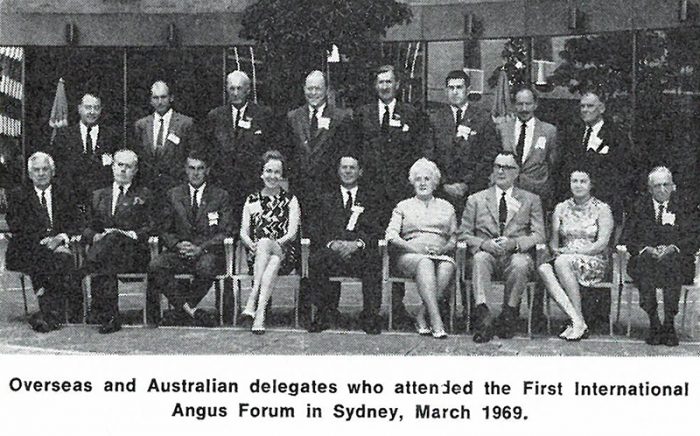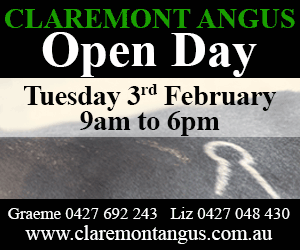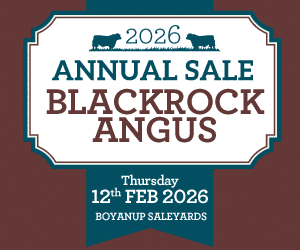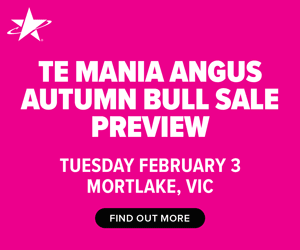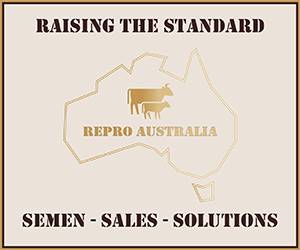While Aberdeen-Angus cattle were given the title of the poor mans breed in the first quarter century of the society, the evident increase of Angus cattle after World War II assisted in changing this stigma. While the Hereford and Shorthorn breeds continued to reign supreme, Angus popularity was growing, particularly amongst wealthy producers whom were taking up breeding Angus cattle.
There were 11 presidents who lead the society during this time. They were LT Sanderson (1945-47, 1951-52), HG Munro (1947-49, 191953-55), RE Wilson (1949-51), LJ Graves (1952-53), RCN Clarke (1955-57), MF White (1957-59), WE Webster (1959-61), HS Corden (1961-63), HT Kidman (1963-65), HW Williams (1965-67), RHF White (1967-69).
Leading from the front
Over the period of 1945- 1969, several Angus studs came to prominence for their exhibiting at shows around Australia.
At the top of the quarter century in 1946, Henry (Harry) Williams and his father Ernest Williams began the Victoree Aberdeen-Angus Stud, near Dalmore in Gippsland, Victoria. Mr Williams has been considered one of the best breeders and showman in Angus history in Australia. Williams founded his herd females based from Lin Sanderson’s Wallah herd, Gus Scott’s Milong Herd, Cliff Minter’s Kahlua stud and the Bontharambo herd, owned by founding society member Hubert Docker.
In 1947, Williams purchased a bull called Mulben Erwin, as well as three females from Scotland. Mulben Erwin’s dam was a three-quarter sister to a very famous bull called Mulben Embassy, sold to Queenslander Eaton Webster of Sarum, Kingaroy in 1945 for an Australian record of 1,500 guineas.
This bull has been said by some to be the greatest bull to ever leave Scotland and had a major impact on the Angus breed in Australia during his lifetime. Prior to his acquisition by Mr Webster, Mulben Embassy was the undefeated Grand Bull Champion over all breeds at the New Zealand show in 1941, 1943, 1944 and 1945. Once settled at Sarum, Mulben Embassy sired 150 sons and 170 daughters, many of which went on to be prominent show animals at various shows around Australia and New Zealand.
William’s purchase of Mulben Erwin and his cow herd assisted in Mr William’s wanting to maintain a large framed herd. In the 1950s and ‘60s, bigger cattle were becoming more sought after, due to the fad of ‘lean meat’ cattle. William’s herd was a champion of maintaining a larger framed herd for their meat content.
“I was placed at the end of the line of the showring until eventually, the fad changed and then we won championship after championship and we used to have the top bull sales in Australia,” Mr Williams said of his decision to breed larger framed cattle.
Over a number of years, Mr Williams became a regular at the shows, winning many awards in the 1950s, 60s and 70s.
Eaton Webster of Sarum Stud, who served as President of the Society from 1959-1961, declared 1948 as the best year for Angus cattle and stated in February 1951, “The beef cattle industry has a great future in this country- perhaps the greatest future of all our primary industries and of the various breeds which go to make up our cattle population, none has greater possibilities than the Angus breed.”
By 1951 20-30 pens of Angus cattle were being sold at the Melbourne cattle market every week, in comparison to the two to three pens 10 years prior. However, in terms of the export market, Angus cattle were still behind the rest.
Another pivotal figure of the Angus society in the second quarter of the century was Lin Sanderson, of Wallah, Narrabri New South Wales. Mr Sanderson was renowned for his quality Angus herd and served twice as Angus Australia President from 1945-1947 and 1951-1952. Mr Sanderson was a vocal advocate for establishing an Australian beef export market to assist in securing a market for high quality beef, potentially to the United Kingdom post WWII.
His work unfortunately did not eventuate to what Mr Sanderson was striving for, as while the Angus breed found a market within the American hamburger export market, much of the market favoured Bos indicus breeds.
Cattle from Mr Sanderson’s Wallah Stud played a large part in many stud’s herds that are still in practice today including Hazeldean, Bald Blair, Roseleigh and Victoree.
Alike Mr Sanderson, another pivotal voice in campaigning the issue of Australia’s quality of beef production during this time was H Gordon Munro, who developed the Booroomooka Angus Stud, based near Bingara, New South Wales, in 1926. History records states that Munro was the first producer to import an animal from the USA with Bar Quality 2nd in 1935.
Munro was of a similar opinion of Sanderson that that there needed to be adaption and change in the quality of Australian meat production in the 1940s. It was his opinion that Australia would benefit from reforms regarding grading and branding meat for local Australian consumption. The Booroomooka Stud is still one of the oldest studs in fruition, now managed by Sinclair Munro and his wife Jo.
In 1961 the Japanese Government purchased 2 Angus bulls and 7 heifers from Australia for stud purposes and artificial insemination cross-breeding, which assisted in the opening of the Japanese export market. During this year, Australia was also visited by representatives from Gaum, Formosa and China, for the purpose of investigating Angus cattle and poll breeding.
Continued growth
June 20, 1956 saw the first combined stud and commercial Angus sale, held in Tamworth. Organised by a group of New South Wales Northern District breeders, the same breeders also organised the first Angus Show and Sales under the Society in June 1957.
By 1958 there were 490 registered Angus studs, with a strong increase of commercial herds around Australia. With this increase of studs around Australia, the state of Victoria saw the highest growth in numbers of Angus breeders over the 25 years.
The Merrigrange Angus stud was founded by Phill and Gwen Collins in in 1959, at Tennyson, VIC with seven cows. The Collins and Merrigrange cattle had a lustrous exhibiting career, claiming numerous championship awards for over twenty years.
The Merrigrange herd produced the Vicky family, one of the prominent Angus lines in Australia. Mr Collins was an early adapter to artificial insemination, going against opinions of other Angus breeders at the time through getting his technicians certified to utilise genetic science to further establish his herd.
Phill and Gwen’s sons Peter and Graeme now run their own Angus studs, Merridale and Merribrook respectively, with their children also having a hand in the Angus breed, making their stamp in the Angus breed multigenerational.
The late 1960s South Australian producers, the Cowley Family of Roseleigh, Pinnaroo were quite dominant across the various Royal Shows. Roseleigh, developed in 1954, had several champion wins across the 60s at the Sydney Royal Easter Show and Melbourne and Adelaide Royal Shows under founder Charles Cowley.
Between 1960 and 1969, the Cowley family had exhibited 23 champions and 3 supremes, as well as 31 firsts, 23 seconds and 15 third prizes winners at the Adelaide, Melbourne and Sydney Royal Shows. Their sire Victoree Erwin 77th was awarded top Angus sire in South Australia in 1964, 1965, 1966 and 1968, with a second place in 1967, and had progeny to go on to take out Champion and Supreme Champion at Adelaide and Sydney Royal Shows.
In Tasmania, Rosedale Angus, Campbell Town, owned by L & M Foster were one of most successful exhibitors within the showring. Formed in 1946, from 1948 to 1969 Rosedale exhibited in many Hobart Royal and Launceston National Shows, collected a number of champion winners during this time. In 1967 champion female and junior champion bull at Hobart Royal in 1967 and Supreme champion bull at the Hobart Royal and Launceston National in 1968. They also had champion carcase at Hobart royal in 1968.
In Western Australia, Gail Holding exhibited a number of reserve champion and champion Angus animals in the Perth Royal Show. Predominantly in the late 1960s, Miss Holding was a regular within the show ring culminating a number of awards, particularly in her female entries.
July 1969 saw the first time Angus cattle were shown at the Alice Springs show in the Northern Territory, with a total of 240 Steers exhibited by Mr Bob Smith of New Crown Station. The cattle travelled over 400 kilometres on a road train to be part of the show.
Leaders in technology and research & development
On February 1, 1960, after much deliberation by Angus producers, the Aberdeen-Angus name was shortened to Angus.
In 1960, the Council of the Society launched the Breed Promotion Scheme, with each State Committee appointing their own Breed Promotion Committee. It was there aim of these committees to “give a greater impetus to the breed” and according to the 1962 Angus Manual accrued excellent results, with an increased number of members, and a greater influx of Progeny, Transfer and Herd Book Registrations.
The 1960s saw progression for the research and development of the Angus breed, with the development of the New South Wales Department of Agriculture, Trangie Research Station Angus Research Project.
While the Angus herd at Trangie was developed many years prior in the 1920s, the Research Project at Trangie became the host herd for the Angus Elite Progeny tests. The research completed at the Trangie Research Station was instrumental for TACE genetic analysis. Trangie also developed satellite herds in other states to conduct Beef CR3 research into feed efficiency and maternal traits. These developments made in the early years have assisted greatly in genomic research in the current day.
By the end of the quarter century the Angus Herd Improvement Group (A.H.I.G) was developed in 1966, which forged the beginnings of performance recording as we know it today.
The goal of the A.H.I.G was to “make the Angus breed in Australia paramount” and was focused on improving and promoting the Angus breed across the supply chain. The Board of Directors for the A.H.I.G in 1966 comprised of Alan Boyd, Gordon Munro, James Litchfield, Hugh Munro, Bruce Steel, Archie Watts, Doug Watts, Doug Service and later Frank Pearson and John Sullivan.
At its establishment, there were 30 members who wanted to be involved in the program and have their cattle tested. In 1968, the explanation for the program was that the breed required records to show its economic capacity to both growers and the butcher.
In 1967, the Angus Society became the first cattle breed society to computerise its performance testing. Representatives of the A.H.I.G, Mr Allen Boyd, Mr James Litchfield and Mr H.P Anderson sighed a five-year contract with the AML and F Computer Bureau to initiate the scheme.
Chairman of Directors of the Angus Herd Improvement Group Alan S. Boyd stated in the 1968 Angus Australia Journal, “The producer needs standards in both aims and goals. With these basics in in mind A.H.I.G has steadily bought forward for its members a system of recording efficiently the performance of his cattle as well as keeping a complete record of management, etc., employed.”
As it was always the aim of the Herd Improvement Group, 1968 saw moves made to ensure that the A.H.I.G would be fully absorbed by the Society. By 1968 the group had over 1,000 cows on its breeder’ computer records.
In 1969 The Angus Herd Improvement Service was set up by the society.
Celebrating success
In 1969, the Society celebrated its Golden Jubilee and celebrated the registration of its 1000th member, who was Mr H.J. Smedley of Wodonga, VIC. In March of the same year the first International Angus Forum was held in Sydney, organised with by the Society. The event was held to celebrate 50 years of the society and was host to 427 delegates from nine countries and had 613 attend the Forum Dinner Dance that took place during the event. This event marked the formation of the World Aberdeen-Angus Secretariat, and gave stud and commercial breeders, scientists and leading authorities in meat trade at the time to come together to discuss their views of the industry they were part of.
The Forum was opened by the Governor of New South Wales, Sir Roden Cutler with an official welcome from the president at the time, Richard White. Mr Smedley was honoured during the Forum Dinner Dance for his membership and its milestone to the society.
The period of 1945-1969 drew to a close with a half century milestone for the society, and a 1,056 strong membership, an all-time peak for the society.

